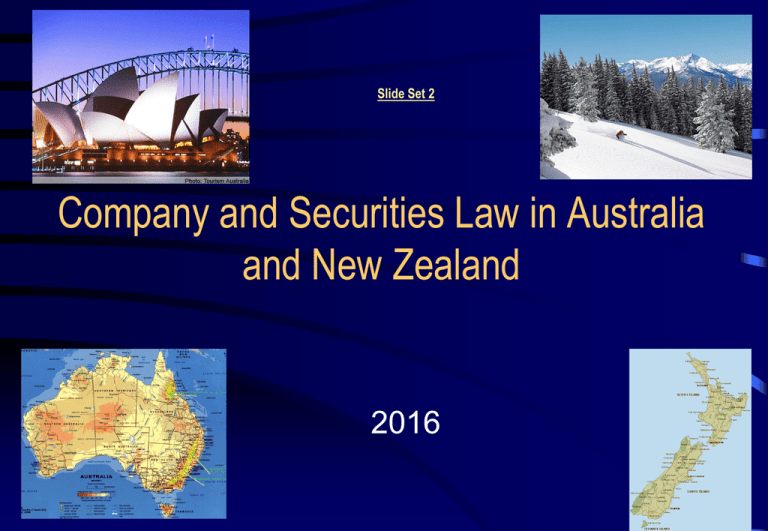Company and Securities Law in Australia and New Zealand 2016 Slide Set 2
advertisement

Slide Set 2 Company and Securities Law in Australia and New Zealand 2016 Types of Companies in Australia and New Zealand Company and Securities Law in Australia and New Zealand Professor Gordon Walker Statistics on Companies • General point: although listed companies get a lot of airplay, they are statistically insignificant – less than 1% of all companies. • The majority of companies are SMEs and these entities are a key private sector employment driver • Listeds often use small subsidiaries to carry out transactions Preliminary Issue: Foreign Investment Consent • If you are acquiring real estate in Australia or New Zealand you need the requisite consents as foreign investors. • Australia: FIRB and AUSFTA. • New Zealand: Overseas Investment Act • Generally speaking, this is a formality. • Familiarise yourself with the relevant websites. Type of Company (Australia) • We use a company limited by shares • Defined in section 9 of the CA. • Liability of members (shareholders) is limited to the amount unpaid (if any) on shares. So if shares are fully paid, no further liability on shareholders in event of insolvency. • Use of “shelf” companies. Section 113 Proprietary Company • No more than 50 non-employee members. • No fundraising (offer to public) but can offer to existing shareholders. • Must have at least one member. • Usually, have pre-emptive rights (you must offer to sell to existing shareholders before selling to third party). • These ingredients common across the former British enclaves. Choice of Vehicle in Australia In Australia, the hierarchy is as follows: • Small proprietary company. • Large proprietary company. • Unlisted public company. • Listed public company. NB: Proprietary companies have “Pty. Ltd” after their names. Public companies have “Ltd” or “Limited” after their names. Choice of Vehicle • Reporting and disclosure obligations increase as you go up the hierarchy. • Another way of conceptualising this point is to say that transaction costs (think Coase) increase as you go up the hierarchy, and, • Since we wish to minimise transaction costs, we will choose a proprietary company on Day One. Proprietary Companies in Australia • See section 45A, Corporations Act (in Handout). • The three tests for distinguishing small and large proprietary companies. This is an accounting characterisation and comes after the event. • The company we will use will end up as a “large” Pty Ltd but it could be single shareholder/single director on Day One. • Company will be incorporated as a Pty Ltd on Day One. Could later change to public unlisted via the section 162 procedure (special resolution – 75% vote). Section 117 Registration • Section 117 describes the registration process. Note ultimate holding company requirement (tax implication). This impacts on shareholding. • Registration and ACN: s. 118. • Jurisdiction of incorporation: s. 119A. • A Pty Ltd must have one director ordinarily resident in Australia: s. 201A. Public companies require 2 directors ordinarily resident. NZ Companies • Pre 1993 Act NZ had a private (same as Pty Ltd in Australia) versus public company distinction. This no longer exists so effectively we have non-listed and listed companies. • The only distinction is the functional distinction: issuers and reporting entities etc. NZ Companies • Incorporation: see ss 10-14. • Can be done online. • One director required to be resident or live in an enforcement country and Australia an enforcement country. • So very easy to incorporate a one director/one shareholder company. The deal will shape the way you set up the company • Using a lawyer in NZ and Australia: Martindale & Hubbell. • Director(s)? Will there be someone onshore? • Shareholders (USA parent or SPV)? • Tax: DTA, CGT. • Handling the money: trust accounts; bankers mandate. Summary • We will incorporate a Pty Ltd in Australia. We will have 3 directors. Why? The issue of whether the company is a small or large Pty Ltd is an accounting issue and arises at the next accounting period (ie, as of 30 June). • In NZ, we will incorporate a non-listed company. It will have 3 directors and one will be resident or from Australia. Again, why? • We don’t need to worry about amending the constitution of either company since we will control the share register. Do you understand this point?





